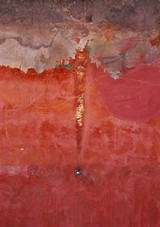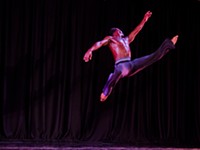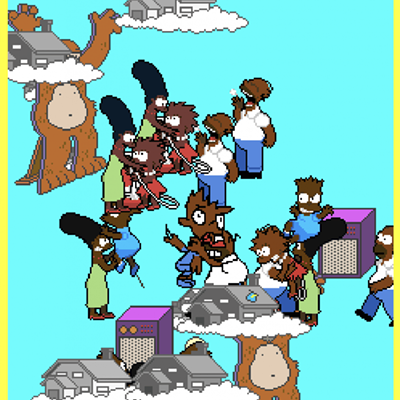[
{
"name": "500x250 Ad",
"insertPoint": "5",
"component": "15667920",
"parentWrapperClass": "",
"requiredCountToDisplay": "1"
}
]
Abstract art is a challenge to approach, and more than once I've overheard a frustrated dismissal of the entire genre. But the reward of spending time with a bewildering puzzle can be great.
The various reasons that abstract art is important are explored in a fascinating letter by art critic Jerry Saltz. Abstraction is a tool, "no less 'real' than philosophy or music," he writes. "It can create beauty, alternative topographies, ugliness, and intense actualities from seeming nothingness." In another section, Saltz calls Rothko's glowing squares "Buddhist TVs," and says they embody what Keats called "good oblivion." I was made aware of this helpful piece of writing by renowned photographer Carl Chiarenza, whose work is included in a small group exhibit of abstract paintings and photographs currently on view at Main Street Arts Gallery.
Chiarenza's portion of the show is a career-spanning sampling, including a bit of textural minutiae from before he abandoned the outside world in favor of his studio; his later meditative photos of chiaroscuro collages; as well as his newer collages, for which he carefully tore up and re-assembled some of his own photography.
These newer works, which each bear the name of a musician, such as "Rossini," "Ludwig," and "Brubeck," are layered, visual soundscape-compositions, with complex dimensions and textures that often include an occasional uncharacteristic shot of color amid the silvers and grays.
Personal associations and reverie tend to surface when I look into Chiarenza's emotionally evocative dreamscapes. "Menotomy 340" and "Noumenon 148," created in 1982 and 1987, respectively, each feature gracefully balanced, layered shapes. The first contains shimmering forms that bring Giacometti's figures to mind, and the latter pairs soft contours with hard edges and a drop off into darkness. Everywhere, patterns abound, light catches the buckled edges of metallic, softly crinkled surfaces, and downy fibers wisp, mist-like, between the realms of light and shadow.
Ithaca-based artist Sarah Sutton's oil-on-panel works are painstaking studies of the topography of crumpled magazine images. In this constructed sea of chaos, forms rise and dissolve as the eye navigates the peaks and ravines, tunnels and waves created by the wads of glossy paper.
By frustrating our instinct to find pattern and meaning in a complex world, Sutton says her work alludes to the "possibility of unintelligibility within the inundation of images that characterizes our current cultural landscape." In "So Your Light May Shine," a network of paper edges and creases pop like bright veins, dividing the planes of recognizable but obfuscated images of hair, flesh, and clothing.
Sutton's "Interstice (1-3)" is even more intriguing. In this large, grayscale triptych, she un-empties the small spaces between objects or points in time. Each of three linen panels is overrun with indefinite gestures of light, dust, webbing, detritus, and growth.
Patricia Wilder's photographs remind me of a passage from Hermann Hesse's "Steppenwolf," in which the culture-harried character notes the serene pleasure with which his eyes greet the rough surface of an age-worn stone wall, free from the deliberate arrangement of shouting design. Wilder has a knack for finding fascination in bits of visual white noise within the urban setting, and her minimalistic emphasis on line, color, and texture is never without a keen sense of balance.
A quad of vibrant, red images showcase small sections of water-damaged walls with peeling paint and pitted surfaces. Here, I detect a smiling face, a streak of heavenly light, a presence, and an act of censorship. Blurry borders between this and that are explored in a grid of nine saturated, Rothko-esque "Color Fields," which, like the rest of Wilder's images, were created without color manipulation. "Oracle" is like a revelation, a sneaky pop of unexpected violet on the other side of a monotonous, pale wall, seen through the thick tunnel of a small, rough window.
Rochester artist Karen Sardisco's large scale, acrylic-on-paper paintings feature layers of linear symbolic forms. Symbols may be representational images, but symbols taken out of personal context are abstractions of private memory and understanding. "In my work natural structures collide with man-made forms to allude to bonds that would be unrecognizable in different situations," Sardisco says in the provided artist statement.
Hearts and knots and geometric forms float amid streaks of murky pigment like diatoms enlarged under a microscope, suspended for our scrutiny, or the scrutiny of memory looking "back at recollections that are now incomplete," she says.
The work of Canandaigua-based artist and Main Street Arts gallery director Bradley Butler resonated powerfully with me when I first viewed it in a 2008 solo show. His work contained foreboding washes of dark seas and swallowing skies, sounding the alarm on the disastrous projections of climate change.
Though the forecasts for our future haven't brightened, Butler's work has become even more engaging as it became even less representational and less anxious. By using his curiosity to push through his dread, he seems to have found security and freedom in losing sight of shore.
In Butler's "Intentionally Losing Direction," portals peek through a smoke-thick atmosphere, and stepping stones save us from a sherbet swamp but lead nowhere in particular. "The Mirage of Truth" contains a brightly amorphous, tempting dream on the horizon, snaking through the dark and beckoning, out of focus as if seen through a shimmering heat wave.
"The Impossibility of Understanding" is like an expanded, philosophic glimpse at the flow of form and energy, each affecting each other subtly, but it's all too complex and too big to see a pattern at this level. Though the titles read like a shrug, Butler's works aren't exactly about futility, they're affirmations of defiant wonder. I feel a nagging urge to zoom out, to see more of it all.
Speaking of...
Latest in Art
More by Rebecca Rafferty
-

Beyond folklore
Apr 4, 2024 -

Partnership perks: Public Provisions @ Flour City Bread
Feb 24, 2024 -

Raison d’Art
Feb 19, 2024 - More »








